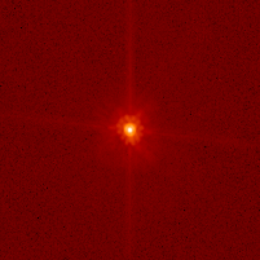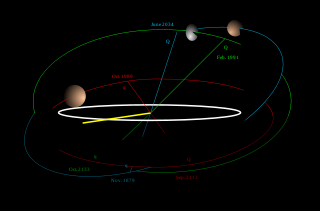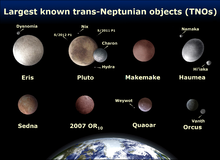
Makemake (dwarf planet)
Did you know...
SOS Children have produced a selection of wikipedia articles for schools since 2005. Click here to find out about child sponsorship.
 Makemake as seen by the Hubble Space Telescope |
|
| Discovery | |
|---|---|
| Discovered by |
|
| Discovery date | March 31, 2005 |
| Designations | |
| MPC designation | (136472) Makemake |
| Pronunciation | / ˌ m ɑː k iː ˈ m ɑː k iː / or / ˌ m ɑː k eɪ ˈ m ɑː k eɪ / |
| Named after | Makemake |
| Alternative names | 2005 FY9 |
| Minor planet category | Dwarf planet, TNO ( cubewano) |
| Adjective | Makemakean |
| Orbital characteristics | |
| Epoch January 28, 1955 ( JD 2 435 135.5) | |
| Aphelion | 53.074 AU 7.939 Tm |
| Perihelion | 38.509 AU 5.760 Tm |
| Semi-major axis | 45.791 AU 6.850 Tm |
| Eccentricity | 0.159 |
| Orbital period | 309.88 yr (113,183 d) |
| Average orbital speed | 4.419 km/ s |
| Mean anomaly | 85.13° |
| Inclination | 28.96° |
| Longitude of ascending node | 79.382° |
| Argument of perihelion | 298.41° |
| Physical characteristics | |
| Dimensions |
|
| Mean radius |
|
| Flattening | 0.05 |
| Surface area | ~6,900,000 km2 |
| Volume | ~1.7 × 109 km3 |
| Mass | ~3 × 1021 kg 0.0005 Earths |
| Mean density | 1.7 ± 0.3 g/cm3 |
| Equatorial surface gravity | ~0.37 m/s2 |
| Escape velocity | ~0.74 km/s |
| Sidereal rotation period | 7.771 ± 0.003 hours |
| Axial tilt | unknown |
| Albedo | 0.77 ± 0.03 (V-band geometric) |
| Temperature | 32–36 K (single-terrain model) 40–44 K (two-terrain model) |
| Spectral type | B-V=0.83, V-R=0.5 |
| Apparent magnitude | 16.7 ( opposition) |
| Absolute magnitude (H) | −0.44 ±0.42 |
|
|
|
Makemake, minor-planet designation 136472 Makemake, is a dwarf planet and perhaps the largest Kuiper belt object (KBO) in the classical population, with a diameter that is about 2/3 the size of Pluto. Makemake has no known satellites, which makes it unique among the largest KBOs and means that its mass can only be estimated. Its extremely low average temperature, about 30 K (−243.2 °C), means its surface is covered with methane, ethane, and possibly nitrogen ices.
Initially known as 2005 FY9 and later given the minor-planet number 136472, it was discovered on March 31, 2005, by a team led by Michael Brown, and announced on July 29, 2005. Makemake was recognized as a dwarf planet by the International Astronomical Union (IAU) in July 2008. Its name derives from Makemake in the mythology of the Rapanui people of Easter Island.
Discovery
Makemake was discovered on March 31, 2005, by a team at the Palomar Observatory, led by Michael Brown, and was announced to the public on July 29, 2005. The team had planned to delay announcing their discoveries of the bright objects Makemake and Eris until further observations and calculations were complete, but announced them both on July 29 when the discovery of another large object they had been tracking, Haumea, was controversially announced on July 27 by a different team in Spain.
Despite its relative brightness (it is about a fifth as bright as Pluto), Makemake was not discovered until well after many much fainter Kuiper belt objects. Most searches for minor planets are conducted relatively close to the ecliptic (the region of the sky that the Sun, Moon and planets appear to lie in, as seen from Earth), due to the greater likelihood of finding objects there. It probably escaped detection during the earlier surveys due to its relatively high orbital inclination, and the fact that it was at its farthest distance from the ecliptic at the time of its discovery, in the northern constellation of Coma Berenices.
Besides Pluto, Makemake is the only other dwarf planet that was bright enough for Clyde Tombaugh to have possibly detected during his search for trans-Neptunian planets around 1930. At the time of Tombaugh's survey, Makemake was only a few degrees from the ecliptic, near the border of Taurus and Auriga, at an apparent magnitude of 16.0. This position, however, was also very near the Milky Way, and Makemake would have been almost impossible to find against the dense background of stars. Tombaugh continued searching for some years after the discovery of Pluto, but he failed to find Makemake or any other trans-Neptunian objects.
Name
The provisional designation 2005 FY9 was given to Makemake when the discovery was made public. Before that, the discovery team used the codename " Easterbunny" for the object, because of its discovery shortly after Easter.
In July 2008, in accordance with IAU rules for classical Kuiper belt objects, 2005 FY9 was given the name of a creator deity. The name of Makemake, the creator of humanity and god of fertility in the mythos of the Rapanui, the native people of Easter Island, was chosen in part to preserve the object's connection with Easter.
Orbit and classification

As of 2009, Makemake is at a distance of 52 astronomical units (7.8×109 km) from the Sun, almost as far from the Sun as it ever reaches on its orbit. Makemake follows an orbit very similar to that of Haumea: highly inclined at 29° and a moderate eccentricity of about 0.16. Nevertheless, Makemake's orbit is slightly farther from the Sun in terms of both the semi-major axis and perihelion. Its orbital period is nearly 310 years, more than Pluto's 248 years and Haumea's 283 years. Both Makemake and Haumea are currently far from the ecliptic—the angular distance is almost 29°. Makemake is approaching its 2033 aphelion, while Haumea passed its aphelion in early 1992.
Makemake is a classical Kuiper belt object, which means its orbit lies far enough from Neptune to remain stable over the age of the Solar System. Unlike plutinos, which can cross Neptune's orbit due to their 2:3 resonance with the planet, the classical objects have perihelia further from the Sun, free from Neptune's perturbation. Such objects have relatively low eccentricities (e below 0.2) and orbit the Sun in much the same way the planets do. Makemake, however, is a member of the "dynamically hot" class of classical KBOs, meaning that it has a high inclination compared to others in its population. Makemake is, probably coincidentally, near the 11:6 resonance with Neptune.
Physical characteristics
Brightness, size, and rotation
Makemake is currently visually the second-brightest Kuiper belt object after Pluto, having a March opposition apparent magnitude of 16.7 in the constellation Coma Berenices. This is bright enough to be visible using a high-end amateur telescope. Combining the detection in infrared by the Spitzer Space Telescope and Herschel Space Telescope with the similarities of spectrum with Pluto yielded an estimated diameter from 1,360 to 1,480 km. From the 2011 stellar occultation by Makemake, its diameter has been measured to be (1502 ± 45) × (1430 ± 9) km. This is slightly larger than Haumea, making Makemake likely the third largest known trans-Neptunian object after Eris and Pluto. Makemake was the fourth dwarf planet recognized, as it has a bright V-band absolute magnitude of −0.44 that practically guarantees it is large enough to achieve hydrostatic equilibrium.
Makemake's high geometrical albedo of 77 percent suggests an average surface temperature of about 32–36 K. From the 2011 stellar occultation, Makemake's density has been estimated to be 1.7 ± 0.3 g/cm,3 using a volatile-retention model for a mass sufficient to allow nitrogen to escape while retaining methane.
Spectra and surface
In a letter written to the journal Astronomy and Astrophysics in 2006, Licandro et al. reported the measurements of the visible and near-infrared spectrum of Makemake. They used the William Herschel Telescope and Telescopio Nazionale Galileo and showed that the surface of Makemake resembles that of Pluto. Like Pluto, Makemake appears red in the visible spectrum, and significantly redder than the surface of Eris (see colour comparison of TNOs). The near-infrared spectrum is marked by the presence of the broad methane (CH4) absorption bands. Methane is observed also on Pluto and Eris, but its spectral signature is much weaker.
Spectral analysis of Makemake's surface revealed that methane must be present in the form of large grains at least one centimetre in size. In addition, large amounts of ethane and tholins may be present as well, most likely created by photolysis of methane by solar radiation. The tholins are probably responsible for the red colour of the visible spectrum. Although evidence exists for the presence of nitrogen ice on its surface, at least mixed with other ices, there is nowhere near the same level of nitrogen as on Pluto and Triton, where it composes more than 98 percent of the crust. The relative lack of nitrogen ice suggests that its supply of nitrogen has somehow been depleted over the age of the Solar System.
The far-infrared (24–70 μm) and submillimeter (70–500 μm) photometry performed by Spitzer and Herschel telescopes revealed that the surface of Makemake is not homogeneous. While the majority of it is covered by nitrogen and methane ices, where the albedo ranges from 78 to 90%, there are small patches of dark terrain whose albedo is only 2 to 12%, and which make up 3–7% of the surface.
Atmosphere
Makemake was expected to have an atmosphere similar to that of Pluto but with a lower surface pressure. However, on 23 April 2011 astronomers had an opportunity to analyze its atmosphere as it passed in front of a 18th magnitude star and abruptly blocked its light. The results showed that Makemake presently lacks a substantial atmosphere and placed an upper limit of 4–12 nanobar for the pressure at its surface.
The presence of methane and possibly nitrogen suggests that Makemake could have a transient atmosphere similar to that of Pluto near its perihelion. Nitrogen, if present, will be the dominant component of it. The existence of an atmosphere also provides a natural explanation for the nitrogen depletion: since the gravity of Makemake is weaker than that of Pluto, Eris and Triton, a large amount of nitrogen was probably lost via atmospheric escape; methane is lighter than nitrogen, but has significantly lower vapor pressure at temperatures prevalent at the surface of Makemake (32–36 K), which hinders its escape; the result of this process is a higher relative abundance of methane.
Lack of satellites
No satellites have been detected around Makemake so far. A satellite having a brightness 1% of that of the primary would have been detected if it had been at the distance 0.4 arcseconds or further from Makemake. This contrasts with the other largest trans-Neptunian objects, which all possess at least one satellite: Eris has one, Haumea has two and Pluto has five. 10% to 20% of all trans-Neptunian objects are expected to have one or more satellites. Because satellites offer a simple method to measure an object's mass, the lack of a satellite makes obtaining an accurate figure for Makemake's mass more difficult.



